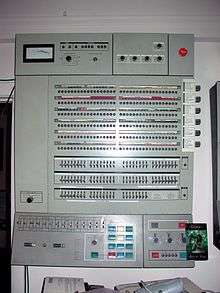IBM System/360 Model 65
The IBM System/360 Model 65 is a member of the IBM System/360 family of computers. It was announced April 1965, and replaced two models, the Model 60 and Model 62, announced one year prior but never shipped.[1]
Models
There are five models of the 360/65.[2]:5 They vary by the amount of core memory with which the system is offered. The G65, H65, I65, IH65 and J65 submodes are configured with 128K, 256K, 512K, 768K or 1M of core memory, respectively.[2] The system can also attach IBM 2361 Large Capacity Storage (LCS) modules which provide up to 8,388,608 bytes of additional storage, however with a considerably slower memory cycle time of 8 microseconds compared to the 750 nanoseconds of processor storage.[2]
Relative performance
The performance of the Model 65 was over triple that of a 360/50, whereas the Model 75, the next step up, was less than double that of a 360/65.[3]
Features

The Model 65 implements the complete System/360 "universal instruction set" architecture, including floating-point, decimal, and character operations as standard features. It offered optional compatibility features to permit emulation of the IBM 7040 and 7044 and the IBM 7090 and 7094,[4] the IBM 7070 and 7074,[5] and the IBM 7080.[6]
Main memory in the Model 65 can be interleaved for faster access.[2]
The Model 65, like the Model 67, was available in a dual-CPU offering. Multi-processing (Dual-CPU) systems have two I65s, IH65s or J65s, and "the main storage of each processing unit is accessible to the other."[2]
Systems software
OS/360 MVT was a fairly typical choice of operating system for the Model 65.
A special version of MVT was needed for the multi-process (dual CPU) Model, called MP65;[7] it used special CPU-to-CPU/Multisystem mode instructions, such as Write Direct.
Time-sharing
Time-sharing could be provided on a Model 65 using IBM's Time Sharing Option (TSO).[8]
See also
- Museum: The Smithsonian Institution has a System/360 Model 65, though it is no longer on public display.
References
- ↑ Pugh et. al., Emerson (1991). "Appendix A - System Introduction Dates 1964-1977". IBM's 360 and Early 370 Systems. MIT.
- 1 2 3 4 5 IBM System/360 Model 65 Punctional Characteristics (PDF). September 1968. A22-6884-3.
- ↑ Padegs, A. (September 1981). "System/360 and Beyond". IBM Journal of Research and Development. IBM. 25 (5): 377–390. doi:10.1147/rd.255.0377.
- ↑ IBM System/360 Special Feature Description-709/7040/7044/7090/7094 II Compatibility Feature for IBM System/360 Models 65 and 67. IBM. A27-2715.
- ↑ IBM System/360 Special Feature Description-7074 Compatibility Feature for System/360 Models 50 and 65. IBM. A27-2717.
- ↑ IBM System/360 Special Feature Description-7080 Compatibility Feature for System/360 Model 65. IBM. A21-2116.
- ↑ Dave Morton (September 2011). "IBM Mainframe Operating Systems: Timeline and Brief Explanation For the IBM System/360 and Beyond". Retrieved September 19, 2016.
- ↑ IBM System/360 Operating System: Time Sharing Option Guide (PDF). IBM. July 1972. GC28-6698.